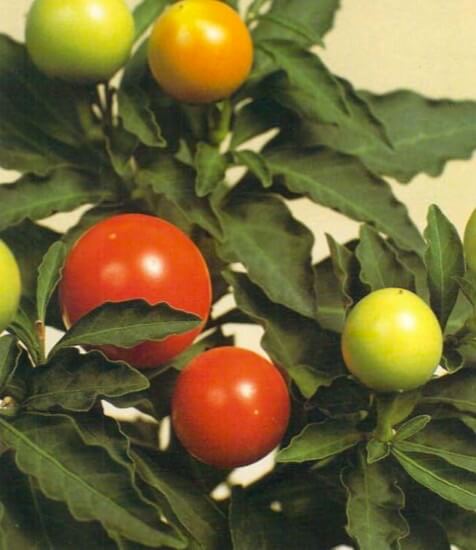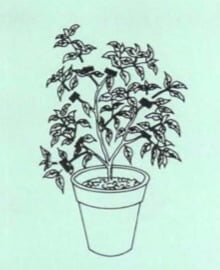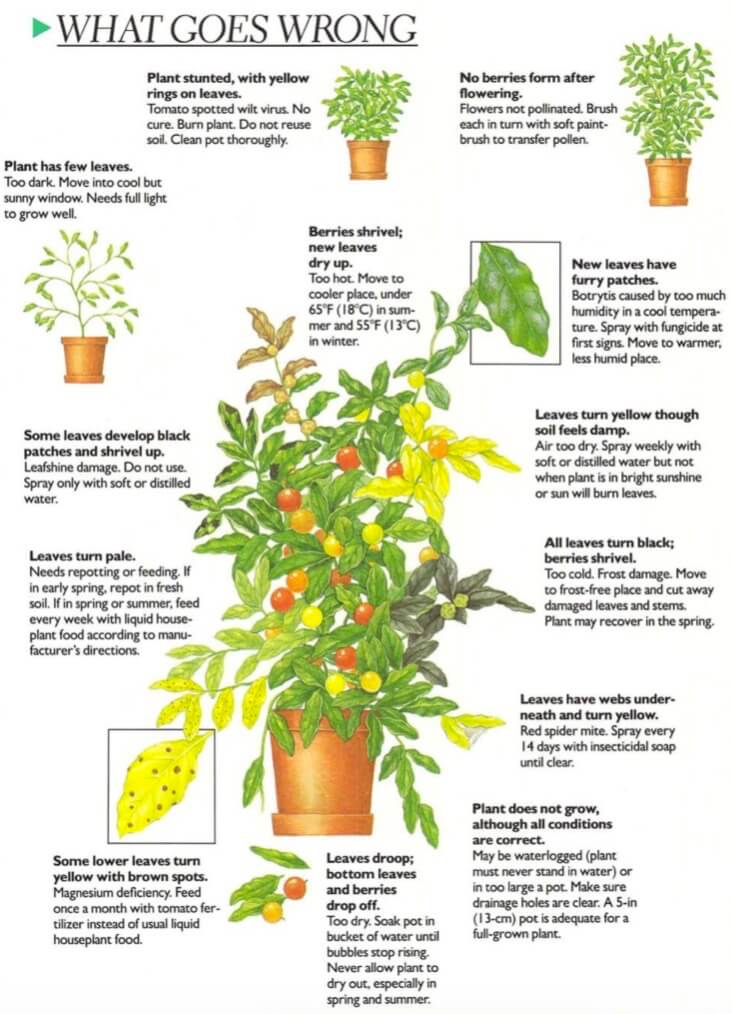[Ebook Việt Hoá] The Instant Guide to Healthy Houseplants (Hướng dẫn tức thời để chăm cây trong nhà khoẻ mạnh), Chi Solanum - Chi Cà
[Ebook Việt Hoá] The Instant Guide to Healthy Houseplants: Solanum capsicastrum (Winter cherry)
- Nguồn: [Ebook Việt Hoá] The Instant Guide to Healthy Houseplants (Hướng dẫn tức thời để chăm cây trong nhà khoẻ mạnh)
- Biên tập: Dũng Cá Xinh
- Biên dịch: Team Codai.net
English
True to its name, the winter cherry in summer produces flowers only; but these are followed in autumn by attractive berries that remain on the plant through the winter and even into early spring. Although not poisonous, they should not be eaten, as they can cause a violently upset stomach. Winter cherries like a sunny (but not too warm) location and should be watered, sprayed and fed regularly during spring and summer. They will grow outside in window boxes in winter, provided they are kept frost free. After the berries have fallen, the plants should be cut back to half their original size. Cut each stem just above a leaf. In autumn, pinch out tips of non-flowering stems. The winter cherry is one of 900 plant species in a family that includes the potato.

Light
Prefers full light, including direct sunlight. Cool but sunny window is ideal.
Temperature
Winter minimum, 40°F (4°C), though 55°F (13°C) is ideal. Summer maximum, 65°F (18°C), especially inside.
Water
2-3 times a week in spring and summer, water so that plant never dries out. Water once every 14 days in winter to keep just moist.
Humidity
Spray daily in summer with soft or distilled water in early morning. Stand pot in saucer of pebbles almost covered with water but do not allow pot base to touch water. Or put pot in outer container or trough of damp peat.
Feeding
Weekly in spring and summer, feed with liquid houseplant food diluted according to manufacturer’s instructions.
Soil
Mix 3 parts loam with I part peat.
Repotting
Repot annually in spring, put- ting gravel in pot for drainage. A 5-in (13-cm) pot is adequate for an adult plant.
Cleaning
Humidity spraying is sufficient. Use no leafshine.
Pruning
In late spring, after berries have fallen, cut back plant to half its original size.

What Goes Wrong

- Plant stunted, with yellow rings on leaves: Tomato spotted wilt virus. No cure. Burn plant. Do not reuse soil. Clean pot thoroughly.
- No berries form after flowering: Flowers not pollinated. Brush each in turn with soft paint- brush to transfer pollen.
- New leaves have furry patches: Botrytis caused by too much humidity in a cool temperature. Spray with fungicide at first signs. Move to warmer, less humid place.
- Leaves turn yellow though soil feels damp: Air too dry. Spray weekly with soft or distilled water but not when plant is in bright sunshine or sun will burn leaves.
- All leaves tum black; berries shrivel: Too cold. Frost damage. Move to frost-free place and cut away damaged leaves and stems. Plant may recover in the spring.
- Leaves have webs under-neath and tum yellow: Red spider mite. Spray every
- 14 days with insecticidal soap until clear.
- Plant does not grow, although all conditions are correct: May be waterlogged (plant must never stand in water) or in too large a pot. Make sure drainage holes are clear. AS-in (13-cm) pot is adequate for a full-grown plant.
- Plant has few leaves: Too dark. Move into cool but sunny window. Needs full light to grow well.
- Some leaves develop black patches and shrivel up: Leafshine damage. Do not use. Spray only with soft or distilled water.
- Leaves turn pale: Needs repotting or feeding. If in early spring, repot in fresh soil. If in spring or summer, feed every week with liquid house-plant food according to manufacturer’s directions.
- Some lower leaves turn yellow with brown spots: Magnesium deficiency. Feed once a month with tomato fertilizer instead of usual liquid houseplant food.
- Leaves droop; bottom leaves and berries drop off: Too dry. Soak pot in bucket of water until bubbles stop rising. Never allow plant to dry out, especially inspring and summer.
- Berries shrivel; new leaves dry up: Too hot. Move to cooler place, under 65°F (18°C) in summer and 55°F (13°C)
Tiếng Việt
Đúng với tên gọi, “anh đào mùa đông” chỉ ra hoa vào mùa hè; nhưng theo sau vào mùa thu xuất hiện những quả mọng hấp dẫn và chúng vẫn còn trên cây qua mùa đông thậm chí vào đầu mùa xuân. Mặc dù không độc nhưng không nên ăn chúng vì chúng có thể gây khó chịu cho dạ dày. Sâm Ấn Độ thích vị trí nhiều nắng (nhưng không quá ấm) và nên được tưới, phun, bón phân thường xuyên trong suốt mùa xuân và mùa hè. Chúng vẫn sẽ phát triển bên ngoài vào mùa đông, miễn là không bị sương giá. Sau khi quả rụng, nên tỉa cây trở lại một nửa kích thước ban đầu. Cắt phần thân phía trên những tán lá. Vào mùa thu, hãy cắt bỏ những ngọn cành không ra hoa. Sâm Ấn Độ là một trong 900 loài thực vật trong họ bao gồm khoai tây.

Ánh sáng
Thích ánh sáng đầy đủ, kể cả ánh nắng trực tiếp. Cửa sổ mát mẻ nhưng đầy nắng là lý tưởng.
Nhiệt độ
Mùa đông tối thiểu 40 độ F (4 độ C), mặc dù 55 độ F (13 độ C) là lý tưởng. Tối đa vào mùa hè 65 độ F (18 độ C), đặc biệt là trong nhà.
Nước
Tưới 2-3 lần một tuần vào mùa xuân và mùa hè để cây không bị khô. Vào mùa đông tưới nước 14 ngày một lần để giữ ẩm.
Độ ẩm
Phun hàng ngày với nước cất hoặc mềm vào sáng sớm mùa hè. Đặt chậu trong đĩa đá cuội gần như ngập nước nhưng không để đế chậu tiếp xúc với nước. Hoặc đặt chậu vào thùng hoặc máng bên ngoài chứa than bùn ẩm.
Bón phân
Hàng tuần vào mùa xuân và mùa hè, sử dụng phân bón hữu cơ pha loãng theo hướng dẫn của nhà sản xuất.
Đất
Trộn 3 phần đất mùn với một phần than bùn.
Thay chậu
Thay chậu hàng năm vào mùa xuân và thêm sỏi vào để thoát nước. Chậu 5 inch (13 cm) là đủ cho cây trưởng thành.
Làm sạch
Phun ẩm vừa đủ. Không sử dụng xịt bóng lá.
Cắt tỉa
Vào cuối mùa xuân, sau khi quả rụng, hãy tỉa cây trở lại kích thước một nửa ban đầu.

Các vấn đề có thể xảy ra

- Cây còi cọc, có vòng tròn màu vàng trên lá: Bệnh héo rũ từ vi rút trên cà chua. Không có thuốc chữa. Cây bỏng. Không tái sử dụng đất. Vệ sinh chậu thật sạch.
- Không có quả sau khi ra hoa: Hoa không thụ phấn. Chải lần lượt từng hạt bằng cọ mềm để chuyển phấn hoa.
- Những chiếc lá mới có những mảng lông: Bệnh nấm do quá ẩm trong nhiệt độ mát mẻ. Phun thuốc diệt nấm khi có dấu hiệu đầu tiên. Di chuyển đến nơi ấm áp hơn, ít ẩm ướt hơn.
- Lá chuyển sang màu vàng do đất ẩm ướt: Không khí quá khô. Hàng tuần phun nước mềm hoặc nước cất nhưng không được phun khi cây ở nơi có nắng chói chang hoặc nắng gắt sẽ làm cháy lá.
- Tất cả quả co rúm lại: Quá lạnh. Thiệt hại do sương giá. Di chuyển đến nơi không có sương giá, cắt bỏ lá và thân bị hư hỏng. Cây có thể phục hồi vào mùa xuân.
- Lá có mạng nhện bên dưới và màu vàng: Nhện đỏ. Phun 14 ngày một lần bằng xà phòng diệt côn trùng cho đến khi hết bệnh.
- Cây không phát triển, mặc dù đáp ứng tất cả điều kiện: Có thể bị úng (cây không bao giờ được đứng trong nước) hoặc trong chậu quá lớn. Đảm bảo lỗ thoát nước thông thoáng. Chậu 5 inch (13 cm) là thích hợp cho cây phát triển.
- Cây ít lá: Quá tối. Di chuyển vào cửa sổ mát mẻ nhưng đầy nắng. Cần đầy đủ ánh sáng để cây phát triển tốt.
- Một số lá xuất hiện các mảng đen và teo lại: Hư hại do xịt bóng lá. Không được dùng. Chỉ xịt bằng nước cất hoặc mềm.
- Lá tái xanh: Cần thay chậu hoặc bón phân. Nếu vào đầu mùa xuân, thay chậu trong đất mới. Nếu vào mùa xuân hoặc mùa hè, bón hàng tuần bằng phân hữu cơ cho cây trong nhà theo hướng dẫn của nhà sản xuất.
- Một số lá phía dưới chuyển sang màu vàng có đốm nâu: Thiếu magie. Bón phân mỗi tháng một lần bằng phân bón cà chua thay vì phân bón hữu cơ thông thường.
- Lá rũ xuống; lá và quả ở dưới rụng: Quá khô. Nhúng chậu vào xô nước cho đến khi hết bọt. Không bao giờ để cây bị khô, đặc biệt là vào mùa xuân và mùa hè.
- Quả teo lại; lá mới khô héo: Nóng quá. Di chuyển đến nơi mát mẻ hơn, dưới 65 độ F (18 độ C) vào mùa hè và 55 độ F (13 độ C)
![[Ebook Việt Hoá] The Instant Guide to Healthy Houseplants: Solanum capsicastrum (Winter cherry) [Ebook Việt Hoá] The Instant Guide to Healthy Houseplants: Solanum capsicastrum (Winter cherry)](https://vn1.vdrive.vn/codai.net/2020/02/ebook-huong-dan-tuc-thoi-cham-cay-trong-nha-khoe-manh-28-solanum-capsicastrum.jpg)


